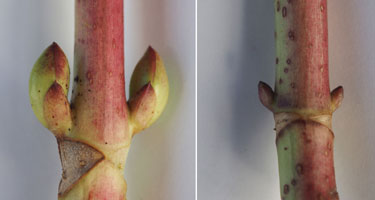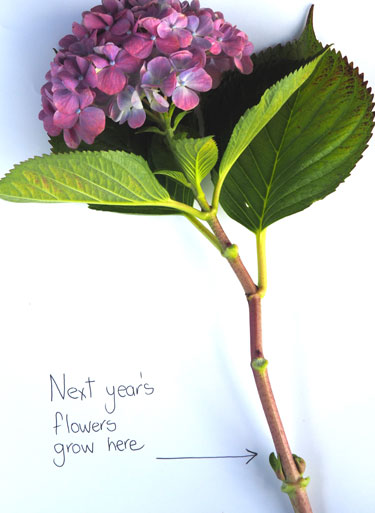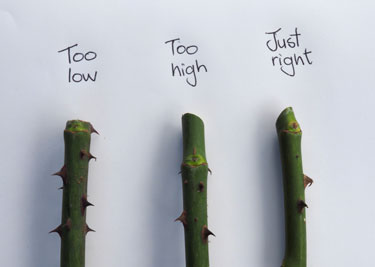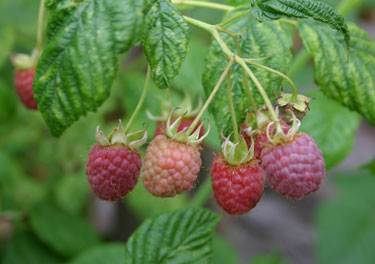When less is more
As the leaves drop from the trees it’s time to reach for the pruning tools.
As a garden matures it needs regular pruning and clearing to maintain the balance of space, light and air to keep everything healthy, productive and beautiful. Once you get the hang of pruning, it is one of the most satisfying garden tasks and not as complicated as it may seem.
Winter is a great time for a cleanup in the garden. Getting rid of plants that fail to thrive or have grown old and tired can give the garden an instant face lift and make space for more promising plants to shine.
On the other hand, sometimes a good prune is all that’s required to make an old plant new again. Rejuvenation happens when the removal of old wood stimulates fresh new growth below. Many an old overgrown shrub will respond well to heavy pruning. You may miss out on flowering for a season or two, but the end result will be well worth the sacrifice.
Shrubs
- Shrubs that bloom in winter or early spring produce their flowers on wood that grew the previous spring. Hence they are pruned immediately after flowering.
- Shrubs that bloom in late spring, summer or autumn on the current season’s growth are pruned in late winter or early spring.
- In cold areas delay pruning until the risk of frost damage is over, even if this delays flowering.
- Vigorous growing evergreens, such as coprosma, will often rejuvenate when pruned hard down to bare wood, however in general it pays to avoid cutting low down into old wood that has no leaves, especially when pruning conifers and lavenders. To encourage bushy growth, trim the entire plant by up to one-third its volume after flowering before new spring growth commences.
- Camellias are best pruned during or immediately after flowering. The more open growing varieties only require pruning if you want to restrict their overall size, but those with thick leafy growth will flower more freely if you thin them to let in light and air.
- Lavender and hebe shrubs should be trimmed every year immediately after flowering. Remove a third to a half of the growth without cutting into any wood without leaves.
- In cold climates, citrus and other frost tender shrubs should not be pruned in autumn as this encourages vulnerable new growth.
- Hydrangeas are pruned in autumn or winter. Cut 1cm above the lowest set of plump flower buds. These will be higher up the branches if bushes are in shade.
Roses
- July and August are the main months for pruning bush roses.
- Take out diseased wood first.
- Remove spindliest and oldest canes and those that grow towards the centre.
- Cut the remaining canes about 5mm above an outward facing bud. Ideally, aim for a basic vase shape leaving three to six evenly spaced branches.
- Old fashioned roses that flower once in early summer (on previous season’s growth) are pruned immediately after flowering.
Flax, ferns, grasses and palms
- Pull or cut tatty leaves and fronds at their base.
- Remove dead leaves from grasses by combing with a plastic rake or gloved hand.
Hedges
- The faster a hedge grows, the more often it will need trimming.
- Cold hardy hedges are trimmed lightly in autumn, and then more severely in spring.
- Small leafed hedges are easily trimmed with an electric trimmer.
Climbers
- Many climbers can be kept in check by snipping out growing tips throughout the spring and summer growing season. Others require hard pruning to keep them under control.
- Generally, mature vines (three years or older) need pruning every year.
- After flowering, remove the oldest canes at ground level then trim the remaining growth by up to a third.
Trim wisteria after flowering to keep the rampant growth tidy over summer; cut the side branches back to about 30cm from the main stem. Then in winter, after the leaves have fallen, shorten them further so that three or four plump flower buds remain on each. If you want your wisteria to grow longer remove basal suckers right back to the main stem after flowering. Or to put the brakes on an over rampant vine leave the suckers on until winter before pruning them out.
Trees
- Prune trees when young to enhance their natural shape or shape them to suit your requirements (such as a 2D espalier, clean trunk umbrella or multi-trunk specimen).
- Prune mature trees only when necessary to control size or remove damaged branches. Think twice before cutting into larger branches. Remove diseased, damaged or crossing over branches.
- Large trees can have their lower limbs removed to allow more light in open up a view or create new space for planting or seating.
- To avoid damaging the tree (or yourself), remove heavy branches piece by piece.
- Flowering trees such as magnolias are pruned immediately after flowering.
- Prune deciduous trees while dormant (without leaves).
Deciduous Fruit Trees
- Fruit trees are pruned to get more light into the tree which translates to better fruiting and flowering.
- Pruning also helps to keep trees small, but an easier option in a small garden is to plant a dwarf variety of a tree grown on a special dwarfing rootstock.
- Prune in winter while trees are without leaves.
- Avoid pruning in wet weather.
- Remove diseased, damaged, inward growing or crossing over branches first.
Raspberries
- Raspberries grow on branches called ‘canes’ that live for 2 years. Canes grow in year one and then flower and fruit in year two.
- Prune close to the ground to remove all the old canes that have finished fruiting.
- On older plants some of the new canes are also ‘thinned out’ leaving only the thickest new canes for next year’s crop.
Pruning basics
- Use clean sharp pruning tools to minimise disease risk. Rubbing blades with steel wool dipped in oil prevent rusts and keep tools in good working order.
- Use a strong enough tool for the job. Secateurs cut up to pencil thickness. For larger branches use loppers. Branches over 20cm thick need a pruning saw.
- Stand back! Look at the whole tree between cuts. Observe and preserve its natural shape.
- After pruning, plants need water to support the rush of new growth.
What to prune when
- WINTER Fruit trees, roses, hydrangeas, grapes, raspberries.
- SPRING Camellias, rhododendrons, daphne, hedges, early spring flowering shrubs that have finished flowering. After frosts: frost-sensitive evergreen shrubs, citrus.
- SUMMER Old-fashioned once-flowering roses, branches hanging over footpaths, rampant vines, perennials that have finished their spring flowering flush, lavender (after flowering). Deadhead spent roses and flowering annuals.
- AUTUMN Hedges, citrus (in frost free climates), English lavender, herbs, hydrangeas. Deadhead roses and flowering annuals.

8-Jun-2017

Left: hydrangea flower buds Right: hydrangea leaf buds


Rose pruning

Wisteria floribunda

Raspberries

